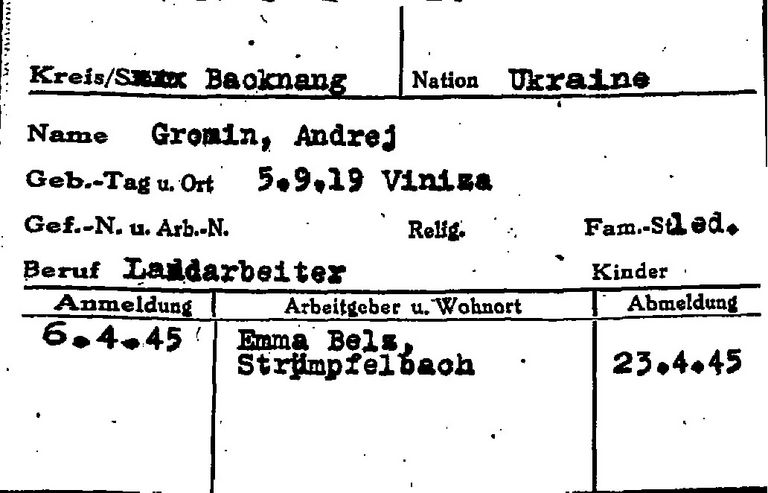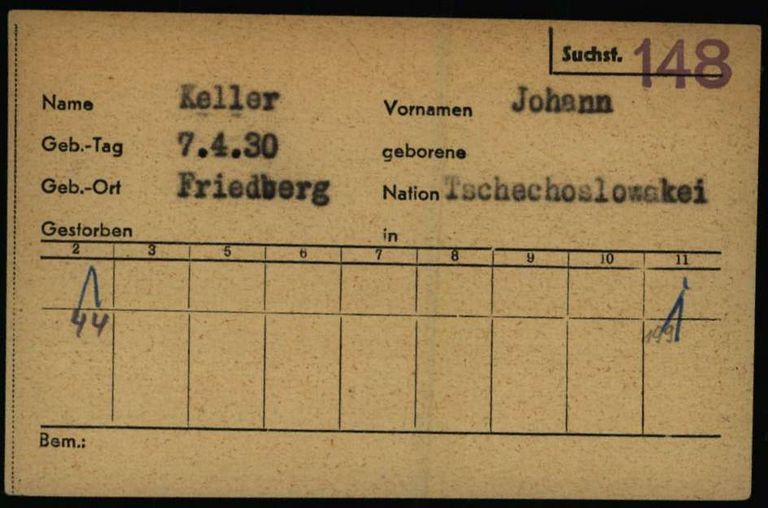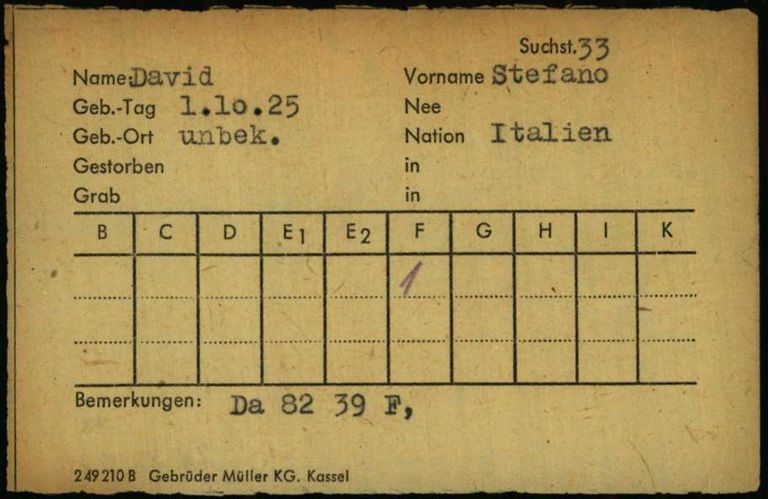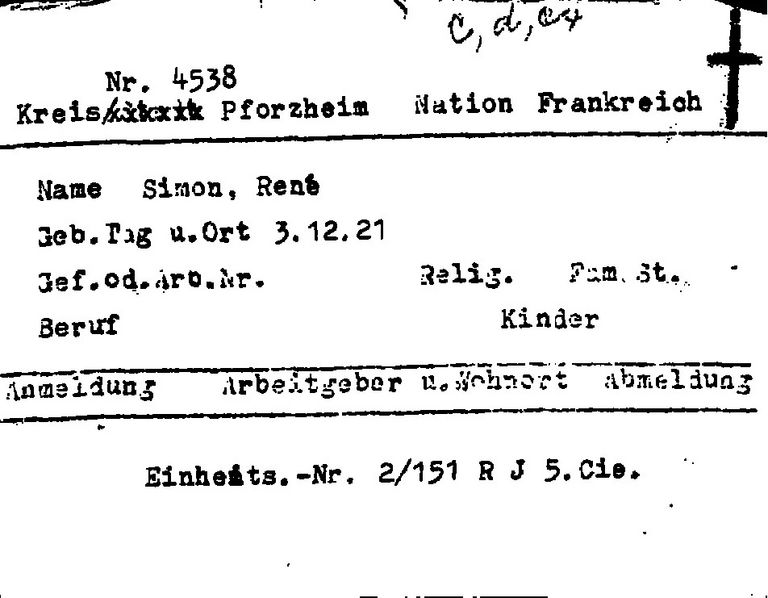Page of
Page/
- Reference
- Intro
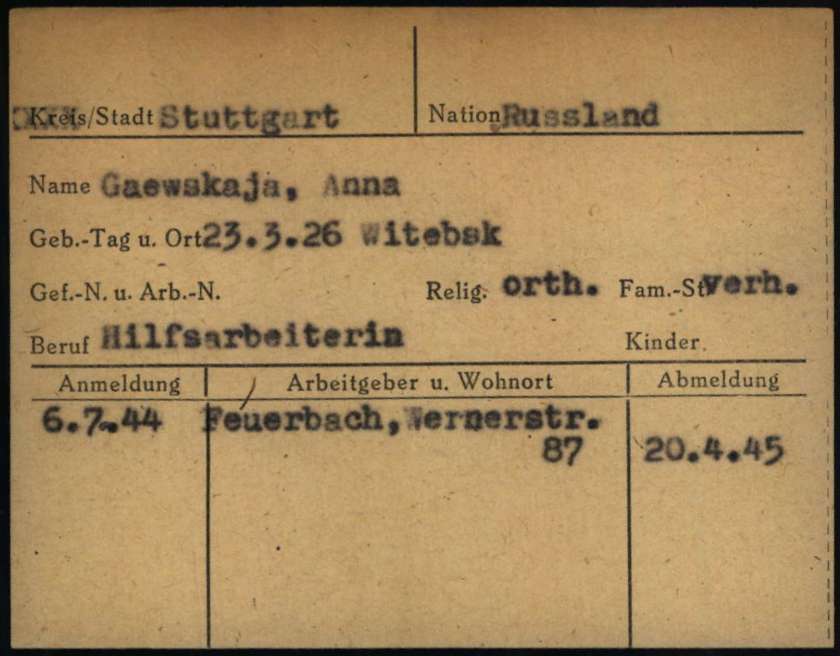

Tracing office cards were created after the end of the Second World War as part of the foreigner tracing campaign (Ausländersuchaktion). German authorities, companies, hospitals, social insurance companies and other agencies in all four occupation zones were required to draw up lists and hand over documents on orders from the Allies. These contained information on non-German citizens who had resided in their district or area of responsibility from 1939 onwards, had died there or were still living there.
The states in the US occupation zone responded differently to the tracing campaign. Whilst lists were produced by those responsible in Bavaria and Hesse, German employees at the relevant offices in Württemberg-Baden created index cards. They recorded the most important information about the foreigners who were registered there – for example, civilian forced laborers, foreign concentration camp prisoners and prisoners of war – on tracing office cards (Suchstellenkarten). The cards are also known as tracing office cards (Württemberg-Baden) or Württemberg-Baden cards.
Tracing office cards were created after the end of the Second World War as part of the foreigner tracing campaign (Ausländersuchaktion). German authorities, companies, hospitals, social insurance companies and other agencies in all four occupation zones were required to draw up lists and hand over documents on orders from the Allies. These contained information on non-German citizens who had resided in their district or area of responsibility from 1939 onwards, had died there or were still living there.
The states in the US occupation zone responded differently to the tracing campaign. Whilst lists were produced by those responsible in Bavaria and Hesse, German employees at the relevant offices in Württemberg-Baden created index cards. They recorded the most important information about the foreigners who were registered there – for example, civilian forced laborers, foreign concentration camp prisoners and prisoners of war – on tracing office cards (Suchstellenkarten). The cards are also known as tracing office cards (Württemberg-Baden) or Württemberg-Baden cards.
Questions and answers
-
Where was the document used and who created it?
The Ministry of the Interior in Stuttgart assigned the cities and administrative districts in Württemberg and North Baden the task of compiling all records and documents on civilian forced laborers, prisoners of war and deceased concentration camp prisoners, and organizing them according to nationality. Local administration employees sifted through the documents that were collected and produced tracing office cards (Suchstellenkarten) based on the information they contained.
All documents and index cards from Württemberg and North Baden were collected by the Württemberg-Baden Ministry of the Interior and handed over to the US Zonal Bureau of Documents and Tracing at the United Nations Relief and Rehabilitation Administration (UNRRA) in Stuttgart. In April 1948, the Bureau moved to Esslingen am Neckar under the direction of the International Refugee Organization (IRO), the successor organization of UNRRA.
- When was the document used?
In an order on January 8, 1946, the US occupying forces called upon the relevant authorities in Württemberg-Baden to compile information on non-German nationals who had resided there since 1939. The Württemberg-Baden Ministry of the Interior commissioned the preprinted blanks of the cards that were required for this in November 1946. From December 1946 onwards, employees in local authorities, cities and administrative districts began creating tracing office cards (Suchstellenkarten).
A large number of the requested documents had already been handed over by the German authorities in all four occupation zones by the spring of 1947. However, since there were still gaps in the records, the United Nations Relief and Rehabilitation Administration (UNRAA), the aid organization responsible for searching for victims of Nazi persecution, again called on the relevant German authorities to hand over documents in March 1947. The International Refugee Organization (IRO), the successor organization of UNRRA, made a final appeal for documents in the summer of 1948. The zonal tracing offices were closed in September 1950 and the records from the US zone were then centralized in Arolsen at the International Tracing Service (ITS), the predecessor institution of the Arolsen Archives.
- What was the document used for?
In the final years of the war, the Allies became increasingly aware that after the end of the war, millions of people would not know where their relatives were or whether they had survived forced labor and imprisonment in concentration camps. For this reason, they decided to set up tracing offices where information on non-German victims of Nazi persecution would be gathered. Individual documents – such as registry office cards from the liberated Buchenwald concentration camp or the registration documents for Displaced Persons – were given directly to these tracing offices or later to the central International Tracing Service (ITS), the predecessor institution of the Arolsen Archives. At the turn of the year 1945/1946, the Allies also issued orders in all four occupation zones as part of the foreigner tracing campaign (Ausländersuchaktion) that information and documents from German authorities, insurance companies, public health insurance funds and other agencies should be collated systematically.
On January 8, 1946, the US military government in Germany (Office of Military Government for Germany U.S., OMGUS) issued a so-called USFET order (USFET = US Forces, European Theatre). “All German authorities within the US zone of occupation in Germany will immediately initiate appropriate action to obtain and report, within the time limits indicated, the information specified herein concerning all military and civilian personnel of the United Nations, who have entered the said zone after 2 September 1939, or who were residing therein on and after that date.” (6.1.1/82514693/ITS Digital Archive, Arolsen Archives). All documents containing information on the fate of civilian forced laborers, prisoners of war and deceased concentration camp prisoners were to be handed over to the United Nations Relief and Rehabilitation Administration (UNRRA).
Staff at the US zone tracing office used the Württemberg-Baden tracing office cards that were created in this context along with the collections of documents provided to trace missing persons and shed light on the unknown fates of victims of Nazi persecution. At the same time, the US military government files and index cards also served to document Nazi forced labor and the associated crimes against civilian forced laborers and prisoners of war.
- How common is the document?
As multiple copies of the tracing office cards had to be handed in, the Württemberg-Baden Ministry of the Interior produced over 5 million preprinted cards in November 1946 and distributed them to the cities and administrative districts in south-west Germany. At least one tracing office card was therefore produced – at least in theory – for all non-German nationals who had resided there after the outbreak of the Second World War or were still living there at the time. In some cases, however, up to five index cards were prepared for one person.
The tracing office cards came to the International Tracing Service (ITS), the predecessor institution of the Arolsen Archives, in 1950 when the US zone tracing office was closed. Staff at the ITS did not collate the tracing office cards in a separate card index, but used an alphabetical-phonetic system to sort them into the Central Name Index (CNI) which contains over 50 million cards. Some tracing office cards can also be found in the War Time Card Index (Collection 2.2.2.1), which contains 4.2 million documents. Exactly how many tracing office cards from Württemberg-Baden are preserved in the Arolsen Archives today is not known. However, modern computer technology will soon be able to find an answer to this question: Clustering techniques make it possible to identify tracing office cards as well as other documents, and to virtually assemble documents of the same type.
- What should be considered when working with the document?
The listing of the civilian forced laborers recorded on the Württemberg-Baden tracing office cards (Suchstellenkarten) is incomplete. Many documents relating to these people were deliberately destroyed by German authorities and private individuals in the last few months of the war. Even after the end of the war, police, judiciary and local government employees destroyed documents relating to civilian forced laborers.
All German authorities also encountered difficulties in carrying out the foreigner tracing campaign from the outset. There was a lack of experienced staff who had been cleared of any involvement in the Nazi regime, and a shortage of typewriters and paper. Moreover, it was initially unclear whether original documents or information in list form were to be handed over to the US occupation authorities. In addition, some of the documents needed for the foreigner tracing campaign had been confiscated by the Allies or destroyed in the course of liberation because their significance was underrated at that moment. The German authorities were therefore no longer able to record in full the information these documents contained.
In addition, the Arolsen Archives collections contain only some of the documents and lists that were evaluated and compiled for the foreigner tracing campaign. Therefore, the information noted on the tracing office cards from Württemberg-Baden can – in the case of some of the people – only be substantiated using other documents. Today, documents relating to civilian forced laborers are kept in various state, district and municipal archives. In some cases, however, documents were lost or destroyed after the foreigner tracing campaign ended.
If you have any additional information about this document, please send your feedback to eguide@arolsen-archives.org. The document descriptions in the e-Guide are updated regularly – and the best way for us to do this is by incorporating the knowledge you share with us.
Help for documents
About the scan of this document <br> Markings on scan <br> Questions and answers about the document <br> More sample cards <br> Variants of the document

